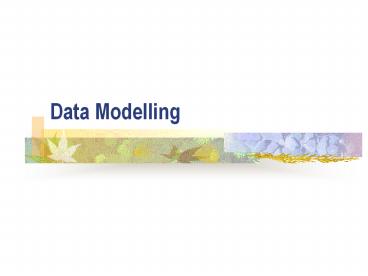Data Modelling - PowerPoint PPT Presentation
1 / 10
Title:
Data Modelling
Description:
Small-scale origins. Individual computers bought for particular applications ... a Customer include Customer ID, Surname, Initials, Title, Address, Credit Limit. ... – PowerPoint PPT presentation
Number of Views:37
Avg rating:3.0/5.0
Title: Data Modelling
1
Data Modelling
2
Introduction
- Historical development with most organisations
- Small-scale origins
- Individual computers bought for particular
applications - Typically batch-processed billing systems and
payroll - Gradual development of systems for other
departments - Systems developed independently
- Many files created, often with different data
structures to suit different programs and even
different operating systems
3
Problems with traditional approach
- Data redundancy
- data duplicated in many different files.
- Data inconsistency
- same data held in different files has to be
updated in each separate file when it changes. - Program-data dependence
- Every computer program has to specify exactly
what data fields constitute a record in the file
being processed. Changes in data structure result
in changes to programs - Lack of flexibility
- Difficult and time-consuming to assemble the data
from the various files and write new programs to
produce the required non-routine reports. - Data was not shareable
- If one department had data that was required by
another department, it was awkward to obtain it.
4
The Database approach
- The concept of a database was born out of a need
to solve the problems caused by the flat-file
systems - Database
- A collection of non-redundant data shareable
between different applications - Company data to be centralised in a common
resource for access by any application - Although solving problems of redundancy and
inconsistency, new problems were created - Unproductive maintenance programs were still
dependent on data structure, so changes required
by one department would require all programs
using that data structure to be changed. - Lack of security all data could potentially be
accessed by all applications
5
Database Management System
- A DBMS is a layer of software inserted between
the data files and the applications - This software goes some way to solving the
remaining problems - Two essential features are
- Program-data independence
- User / application does not need to be aware of
the data storage structure - User access restrictions
- Each user is limited to applicable data
6
The conceptual data model
- From the statement of data requirements a
conceptual data model is produced. - This describes how the data elements in the
database are to be grouped. - Three terms are used to describe the data
requirements - An entity is a thing of interest to an
organisation about which data is to be
heldExamples of entities include Customer,
Employee, Stock Item, Supplier. - An attribute is a property or characteristic of
an entityExamples of attributes associated with
a Customer include Customer ID, Surname,
Initials, Title, Address, Credit Limit. - A relationship is a link or association between
entitiesAn example is the link between Dentist
and Patient one dentist has many patients, but
each patient only has one dentist.
7
Types of relationship
- There are only three different degrees of
relationship between two attributes. A
relationship may be - One-to-one e.g. the relationship between Husband
and Wife, or between Householder and Main
Residence - One-to-many e.g. the relationship between Mother
and Children, between Customer and Order, between
Borrower and Library Book - Many-to-many e.g. the relationship between
Student and Course, between Stock Item and
Supplier, between Film and Film Star
8
Entity-relationship diagrams
- An entity-relationship diagram is a diagrammatic
way of representing the relationships between the
entities in a database.
9
A hospital in-patient system
- A hospital is organised into a number of wards.
- Each ward has a ward number and a name recorded,
along with a number of beds in that ward. - Each ward is staffed by nurses.
- Nurses have their staff number and name recorded,
and are assigned to a single ward. - Each patient in the hospital has a patient
identification number, and their name, address
and date of birth are recorded. - Each patient is under the care of a single
consultant and is assigned to a single ward. - Each consultant is responsible for a number of
patients. - Consultants have their staff number, name and
specialism recorded.
10
Exercise on In-patient system
- State 4 entities for the system giving a suitable
identifier for each entity. - Draw an entity-relationship diagram to show the
relationships between the entities.































